Review on the Evolution of Darrieus Vertical Axis Wind Turbine: Large Wind Turbines
Abstract
:1. Introduction
2. The Invention of the Darrieus Turbine
3. Large Vertical Axis Wind Turbines
3.1. DAF Indal
3.2. Sandia National Laboratories
3.3. ALCOA
3.4. Adecon, VAWT Power and Vestas VAWT
3.5. FloWind
3.6. EOLE and Heidelberg
3.7. Musgrove Turbines (VAWT 450 and VAWT 850)
3.8. Aerogenerator
3.9. Vertical Wind AB
3.10. Skwid-MODEC
3.11. VertAx Wind
3.12. Vertiwind
3.13. ANew Turbines
4. Conclusions
Author Contributions
Funding
Conflicts of Interest
References
- A Brief History of Wind Power Development in Canada 1960s–1990s. Available online: http://www.inference.org.uk (accessed on 20 May 2019).
- Kumar, P.M.; Purimitla, S.R.; Shubhra, S.; Srikanth, N. Numerical and analytical study on telescopic savonius turbine blade. In Proceedings of the 2017 3rd International Conference on Power Generation Systems and Renewable Energy Technologies (PGSRET), Johor Bahru, Malaysia, 4–6 April 2017; pp. 107–112. [Google Scholar]
- Kumar, P.M.; Ajit, K.R.; Srikanth, N.; Lim, T.-C. On the Mathematical Modelling of Adaptive Darrieus Wind Turbine. J. Power Energy Eng. 2017, 5, 133–158. [Google Scholar] [CrossRef] [Green Version]
- Palanisamy Mohan Kumar, S.A.; Narasimalu, S.; Lim, T.-C. Optimization, Design, and Construction of Field Test Prototypes of Adaptive Hybrid Darrieus Turbine. J. Fundam. Renew. Energy Appl. 2017, 7, 245. [Google Scholar]
- Kumar, M.; Surya, M.M.R.; Sin, N.P.; Srikanth, N. Design and experimental investigation of airfoil for extruded blades. Int. J. Adv. Agric. Environ. Eng. 2017, 3. [Google Scholar]
- Kumar, P.M.; Kulkarni, R.; Srikanth, N.; Lim, T.-C. Performance Assessment of Darrieus Turbine with Modified Trailing Edge Airfoil for Low Wind Speeds. Smart Grid Renew. Energy 2017, 8, 425. [Google Scholar] [CrossRef]
- Kumar, P.M.; Rashmitha, S.R.; Srikanth, N.; Lim, T.-C. Wind Tunnel Validation of Double Multiple Streamtube Model for Vertical Axis Wind Turbine. Smart Grid Renew. Energy 2017, 8, 412–424. [Google Scholar] [CrossRef] [Green Version]
- Kumar, P.M.; Surya, M.M.R.; Srikanth, N. On the improvement of starting torque of darrieus wind turbine with trapped vortex airfoil. In Proceedings of the 2017 IEEE International Conference on Smart Grid and Smart Cities (ICSGSC), Singapore, 23–26 July 2017; pp. 120–125. [Google Scholar]
- Mohan Kumar, P.; Surya, M.R.; Sivalingam, K.; Lim, T.-C.; Ramakrishna, S.; Wei, H. Computational Optimization of Adaptive Hybrid Darrieus Turbine: Part 1. Fluids 2019, 4, 90. [Google Scholar] [CrossRef]
- Palanisamy Mohan Kumar, K.S.; Narasimalu, S.; Lim, T.; Ramakrishna, S. A Review on the Evolution of Darrieus Vertical Axis Wind Turbine: Small Wind Turbines. J. Power Energy Eng. 2019, 7, 27–44. [Google Scholar] [CrossRef] [Green Version]
- Darrieus, G. Turbine Having Its Rotating Shaft Transverse to the Flow of the Current. U.S. Patent 1835018, 8 December 1931. [Google Scholar]
- Templin, R.; Rangi, R. Vertical-axis wind turbine development in Canada. IEE Proc. A 1983, 130, 555–561. [Google Scholar] [CrossRef]
- Adamek, A.; Tudor, S. A Brief History of Wind Power Development in Canada 1960–1990s; Canada Science and Technology Museum: Ottawa, ON, Canada, 2015. [Google Scholar]
- Naar, J. The new wind power. In Passive and Low Energy Alternatives I; Elsevier: Amsterdam, The Netherlands, 1982; pp. 12-11–12-16. [Google Scholar]
- Paraschivoiu, I. Wind Turbine Design: With Emphasis on Darrieus Concept; Presses Internationales Polytechnique: Montréal, QC, Canada, 2002. [Google Scholar]
- Schienbein, L. Development and testing of the DAF Indal 6400–6500 kW VAWT. In Intersol Eighty Five; Elsevier: Amsterdam, The Netherlands, 1986; pp. 2172–2176. [Google Scholar]
- Penna, P. The DAF Indal ltd. series 6400 VAWT at the Atlantic wind test site: Performance and structural dynamic test data. In Intersol Eighty Five; Elsevier: Amsterdam, The Netherlands, 1986; pp. 2167–2171. [Google Scholar]
- Malcolm, D. Structural Response of the DAF Indal 6400 VAWT. In Fourth Asme Wind Energy Symposium, 1985; Swift, A.H.P., Ed.; Amer Society of Mechanical: New York, NY, USA, 1985; pp. 13–22. [Google Scholar]
- Schienbein, L.; Malcolm, D. Design, performance, and economics of 50-kW and 500-kW vertical axis wind turbines. J. Sol. Energy Eng. 1983, 105, 418–424. [Google Scholar] [CrossRef]
- DAF Indal. Available online: http://www.wind-works.org/cms/index.php?id=501 (accessed on 20 May 2019).
- Wehrey, M.; Yinger, S. Demonstration testing of the daf indal ltd, 50 kw vertical axis wind turbine generator—A fourteen month experience. In Third ASME Wind Energy Symposium; Amer Society of Mechanical: New York, NY, USA, 1983. [Google Scholar]
- Sutherland, H.J.; Berg, D.E.; Ashwill, T.D. A Retrospective of VAWT Technology; Sandia Report No. SAND2012-0304; Sandia National Laboratories: Albuquerque, NM, USA, 2012. [CrossRef]
- Klimas, P.; Dodd, H.; Clark, R. An overview of the DOE/SANDIA/USDA vertical axis wind turbine Test Bed Project. In Proceedings of the Windpower‘87, San Francisco, CA, USA, 5 October 1987. [Google Scholar]
- Johnston, S.F., Jr. Proceedings of the Vertical Axis Wind Turbine (VAWT) Design Technology Seminar for Industry; Sandia Laboratories: Albuquerque, NM, USA, 1980.
- Liu, W.; Paraschivoiu, I.; Martinuzzi, R. Calculation of dynamic stall on sandia 34-m VAWT using an indicial model. Wind Eng. 1992, 16, 313–325. [Google Scholar]
- Dodd, H.; Ashwill, T.; Berg, D.; Ralph, M.; Stephenson, W.; Veers, P. Test Results and Status of the DOE/Sandia 34-M VAWT Test Bed; Sandia National Laboratories: Albuquerque, NM, USA, 1989.
- Ralph, M.E. Control of the variable speed generator on the Sandia 34-metre vertical axis wind turbine. Presented at the Windpower’89, San Francisco, CA, USA, 24–27 September 1989. [Google Scholar]
- Berg, D.E. Structural Design of the Sandia 34-Meter Vertical-Axis Wind Turbine; Sandia National Laboratories: Albuquerque, NM, USA, 1985.
- Ashwill, T.D. Structural design and fabrication of the Sandia 34-meter Vertical Axis Wind Turbine. Presented at the ASME/JSME/ISES Solar Energy Conference, Honolulu, HI, USA, 22 March 1987. [Google Scholar]
- Ashwill, T.D. Measured Data for the Sandia 34-Meter Vertical Axis Wind Turbine; Sandia National Laboratories: Albuquerque, NM, USA, 1992.
- Damota, J.; Lamas, I.; Couce, A.; Rodriguez, J.D. Vertical Axis Wind Turbines: Current Technologies and Future Trends. In Proceedings of the International Conference on Renewable Energies and Power Quality (ICREPQ’15), La Coruña, Spain, 25–27 March 2015; pp. 530–535. [Google Scholar]
- ALCOA ALVAWT 500 kW. Available online: http://www.wind-works.org/cms/index.php?id=504 (accessed on 20 May 2019).
- Möllerström, E.; Gipe, P.; Beurskens, J.; Ottermo, F. A historical review of vertical axis wind turbines rated 100 kW and above. Renew. Sustain. Energy Rev. 2019, 105, 1–13. [Google Scholar] [CrossRef]
- VAWTPower 60 kW. Available online: http://www.wind-works.org/cms/index.php?id=719 (accessed on 20 May 2019).
- Vestas 9 kW. Available online: http://www.wind-works.org/cms/index.php?id=505 (accessed on 20 May 2019).
- Touryan, K.; Strickland, J.; Berg, D. Electric power from vertical-axis wind turbines. J. Propuls. Power 1987, 3, 481–493. [Google Scholar] [CrossRef]
- FloWind. Available online: http://www.wind-works.org/cms/index.php?id=509 (accessed on 20 May 2019).
- Eriksson, S.; Bernhoff, H.; Leijon, M. Evaluation of different turbine concepts for wind power. Renew. Sustain. Energy Rev. 2008, 12, 1419–1434. [Google Scholar] [CrossRef]
- Hulls, J.R. Vertical Axis Wind Turbine with Blade Tensioner. U.S. Patent 5531567A, 2 July 1996. [Google Scholar]
- D’Ambrosio, M.; Medaglia, M. Vertical Axis Wind Turbines: History, Technology and Applications. Master’s Thesis, Halmstad University, Halmstad, Sweden, 2010. [Google Scholar]
- Wallace, V.R.; McMullen, M.S.; Archibald, W.R. Vertical Axis Wind Turbine with Pultruded Blades. U.S. Patent 5375324A, 27 December 1994. [Google Scholar]
- Carne, T.; Lauffer, J.P.; Gomez, A.J. Modal Testing the EOLE; Sandia National Laboratories: Albuquerque, NM, USA, 1987.
- Eole. Available online: http://www.wind-works.org/cms/index.php?id=506 (accessed on 20 May 2019).
- Heidelberg VAWT. Available online: https://www.mwps.world/market/offered/industrial-wind-turbines/heidelberg-wind-turbines-for-sale-refurbishing-available/ (accessed on 20 May 2019).
- Musgrove, P. Wind Power; Cambridge University Press: Cambridge, UK, 2009. [Google Scholar]
- Price, T.J. UK large-scale wind power programme from 1970 to 1990: The Carmarthen Bay experiments and the musgrove vertical-axis turbines. Wind Eng. 2006, 30, 225–242. [Google Scholar] [CrossRef]
- Morgan, C.; Gardner, P.; Mays, I.; Anderson, M. The demonstration of a stall regulated 100 kW vertical axis wind turbine. In Proceedings of the European Wind Energy Conference, Glasgow, UK, 10–13 July 1989. [Google Scholar]
- Musgrove, P. Wind energy conversion: Recent progress and future prospects. Solar Wind Technol. 1987, 4, 37–49. [Google Scholar] [CrossRef]
- Musgrove VAWT. Available online: https://www.researchgate.net/figure/Major-components-of-Musgrove-rotor-49_fig16_266799978 (accessed on 20 May 2019).
- Mays, I.; Morgan, C.; Anderson, M.; Powles, S. The 500 kW VAWT 850 is now operating. Mod. Power Syst. 1990, 10, 53–55, 57. [Google Scholar]
- Aerogenerator Turbine Sets Sail for a Greener Future. Available online: http://www.guardian.co.uk/technology/2008/jan/29/wind.energy.aerogenerator (accessed on 10 May 2019).
- Aerogenerator VAWT. Available online: http://eprints.whiterose.ac.uk/79230/1/ener166-007.pdf (accessed on 20 May 2019).
- Aerogenerator X Launced by Wind Power Limited. Wind Power Ltd. Available online: https://www.scribd.com/document/155485918/Aerogenerator-X-Release-26-07-10 (accessed on 10 May 2019).
- Shires, A. Design optimisation of an offshore vertical axis wind turbine. Proc. ICE-Energy 2013, 166, 7–18. [Google Scholar] [CrossRef] [Green Version]
- Vertical Wind AB. Available online: http://www.verticalwind.se/teknik/ (accessed on 6 May 2019).
- Apelfröjd, S.; Eriksson, S.; Bernhoff, H. A review of research on large scale modern vertical axis wind turbines at Uppsala University. Energies 2016, 9, 570. [Google Scholar] [CrossRef]
- Kjellin, J.; Bernhoff, H. Electrical starter system for an H-rotor type VAWT with PM-generator and auxiliary winding. Wind Eng. 2011, 35, 85–92. [Google Scholar] [CrossRef]
- Möllerström, E.; Ottermo, F.; Hylander, J.; Bernhoff, H. Eigen frequencies of a vertical axis wind turbine tower made of laminated wood and the effect upon attaching guy wires. Wind Eng. 2014, 38, 277–289. [Google Scholar] [CrossRef]
- Möllerström, E.; Ottermo, F.; Hylander, J.; Bernhoff, H. Noise emission of a 200 kW vertical axis wind turbine. Energies 2016, 9, 19. [Google Scholar] [CrossRef]
- Ottermo, F.; Möllerström, E.; Nordborg, A.; Hylander, J.; Bernhoff, H. Location of aerodynamic noise sources from a 200 kW vertical-axis wind turbine. J. Sound Vib. 2017, 400, 154–166. [Google Scholar] [CrossRef]
- Möllerström, E.; Larsson, S.; Ottermo, F.; Hylander, J.; Bååth, L. Noise propagation from a vertical axis wind turbine. In Proceedings of the 43rd International Congress on Noise Control Engineering, Melbourne, Australia, 16–19 November 2014. [Google Scholar]
- Skwid. Available online: https://newatlas.com/skwid-wind-tidal-power-japan/27559/ (accessed on 8 May 2019).
- Mohan Kumar, P.; Surya, M.M.R.; Narasimalu, S.; Lim, T.-C. Experimental and numerical investigation of novel Savonius wind turbine. Wind Eng. 2019, 43, 247–262. [Google Scholar] [CrossRef]
- Hybrid Floating VAWT Sinks off Japanese Coast. Available online: https://www.windpoweroffshore.com/article/1327126/japanese-hybrid-floating-turbine-sinks (accessed on 8 May 2019).
- MODEC Retrieves Sunken SKWID Unit. Available online: https://marineenergy.biz/2015/06/03/modec-retrieves-sunken-skwid-unit/ (accessed on 8 May 2019).
- Kumar, P.M.; Surya, M.M.R.; Kethala, R.; Srikanth, N. Experimental investigation of the performance of darrieus wind turbine with trapped vortex airfoil. In Proceedings of the 2017 3rd International Conference on Power Generation Systems and Renewable Energy Technologies (PGSRET), Johor Bahru, Malaysia, 4–6 April 2017; pp. 130–135. [Google Scholar]
- VertAx Wind. Available online: http://vertaxwind.com/ (accessed on 3 May 2019).
- VertAx Wind Blades. Available online: http://vertaxwind.com/technology.php#blades (accessed on 3 May 2019).
- Keysan, O.; McDonald, A.; Mueller, M.; Doherty, R.; Hamilton, M. C-GEN, a lightweight direct drive generator for marine energy converters. In Proceedings of the 5th IET International Conference on Power Electronics, Machines and Drives (PEMD 2010), Brighton, UK, 19–21 April 2010. [Google Scholar]
- VertAx Wind Electrical Generation. Available online: http://vertaxwind.com/technology.php#electrical (accessed on 3 May 2019).
- VertAx Wind Crane. Available online: http://vertaxwind.com/technology.php#crane (accessed on 3 May 2019).
- VertiWind. Available online: http://www.sunwindenergy.com/news/vertical-axis-turbines-mediterranean (accessed on 20 May 2019).
- Vertiwind-Data. Available online: https://www.windpowerengineering.com/design/floating-vertical-axis-turbine-makes-waves-in-europe/ (accessed on 3 May 2019).
- Vertiwind. Available online: https://www.windpoweroffshore.com/article/1462375/vertical-axis-firm-nenuphar-enters-liquidation (accessed on 3 May 2019).
- ANew 15KW ANEW-S1. Available online: https://www.anew-institute.com/vertical-wind-turbine.html (accessed on 6 May 2019).
- ANew 200KW ANEW-M1. Available online: https://www.anew-institute.com/anew-m1-vawt.html (accessed on 6 May 2019).
- Eriksson, S.; Bernhoff, H.; Bergkvist, M. Design of a unique direct driven PM generator adapted for a telecom tower wind turbine. Renew. Energy 2012, 44, 453–456. [Google Scholar] [CrossRef]
- ANew 1.5MW ANEW-B1. Available online: https://www.anew-institute.com/anew-b1-vawt.html (accessed on 6 May 2019).
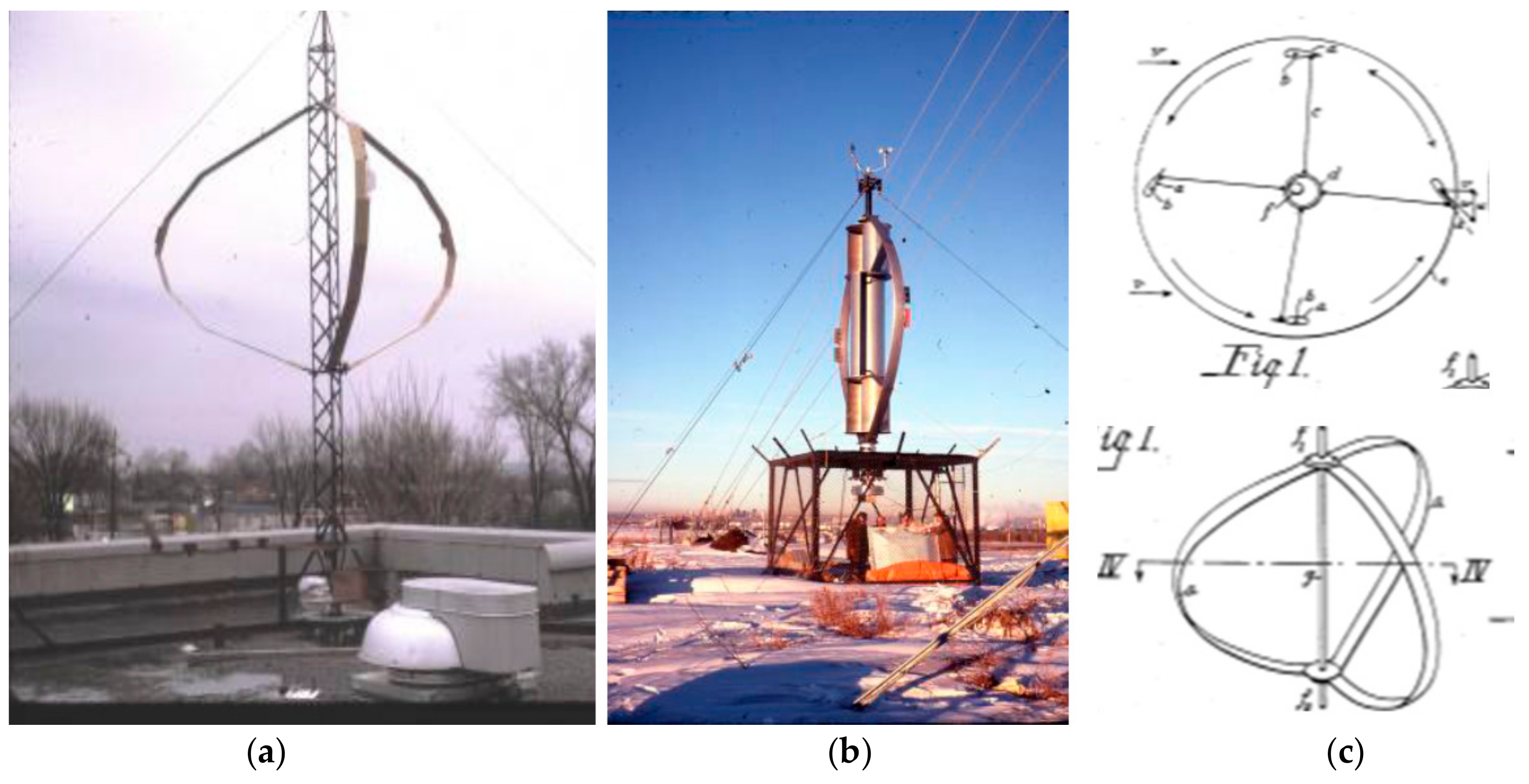
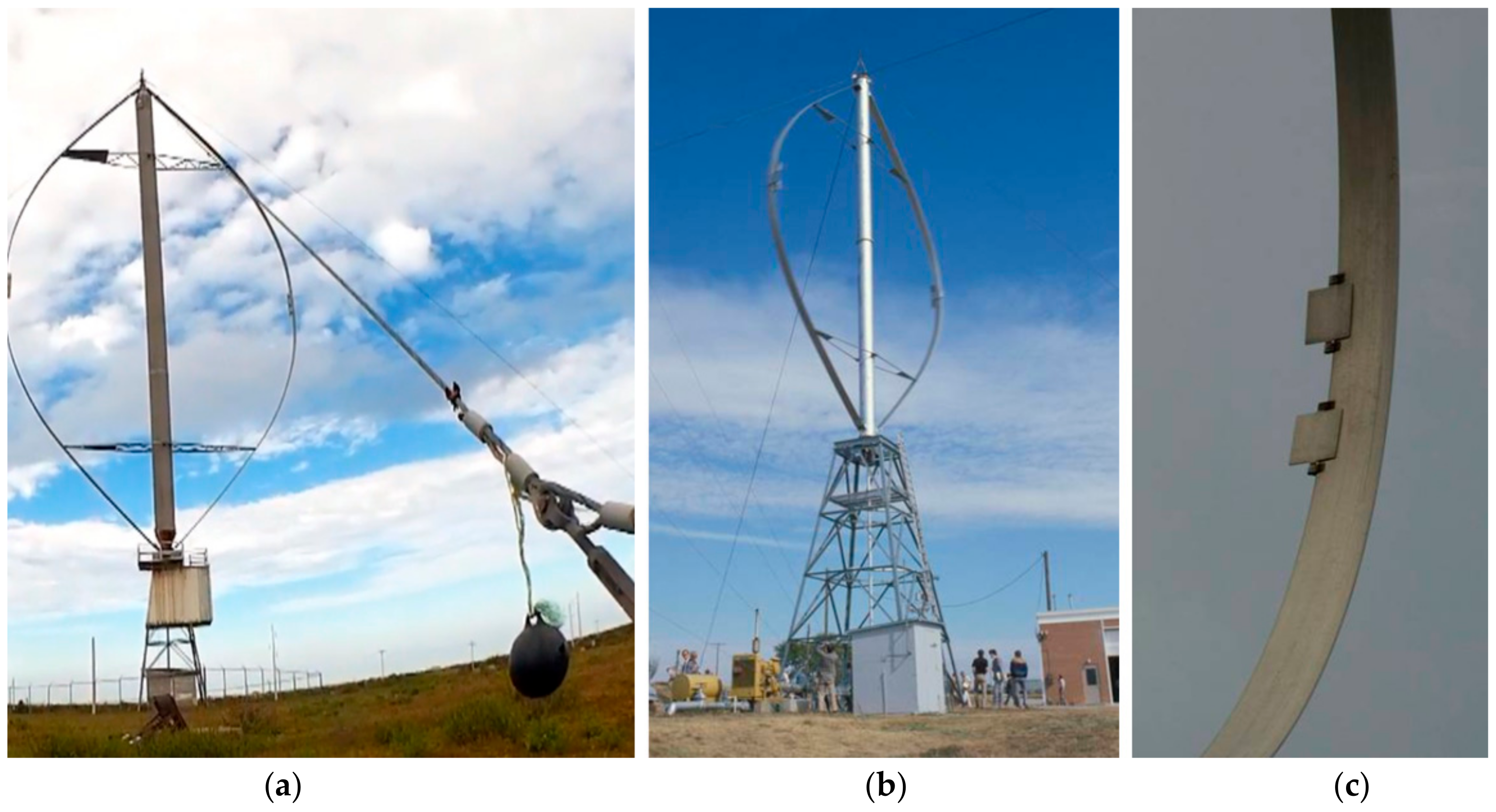
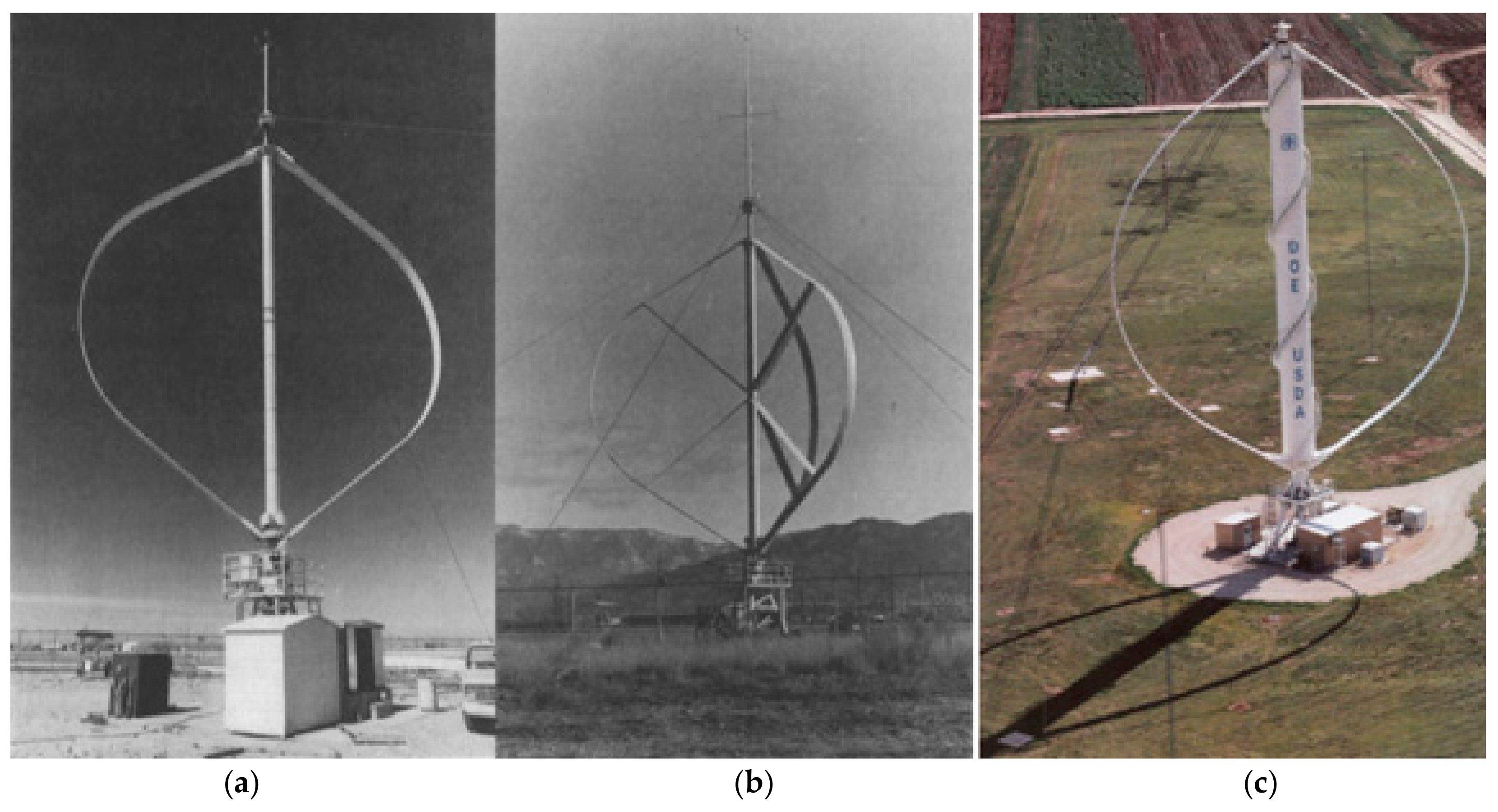

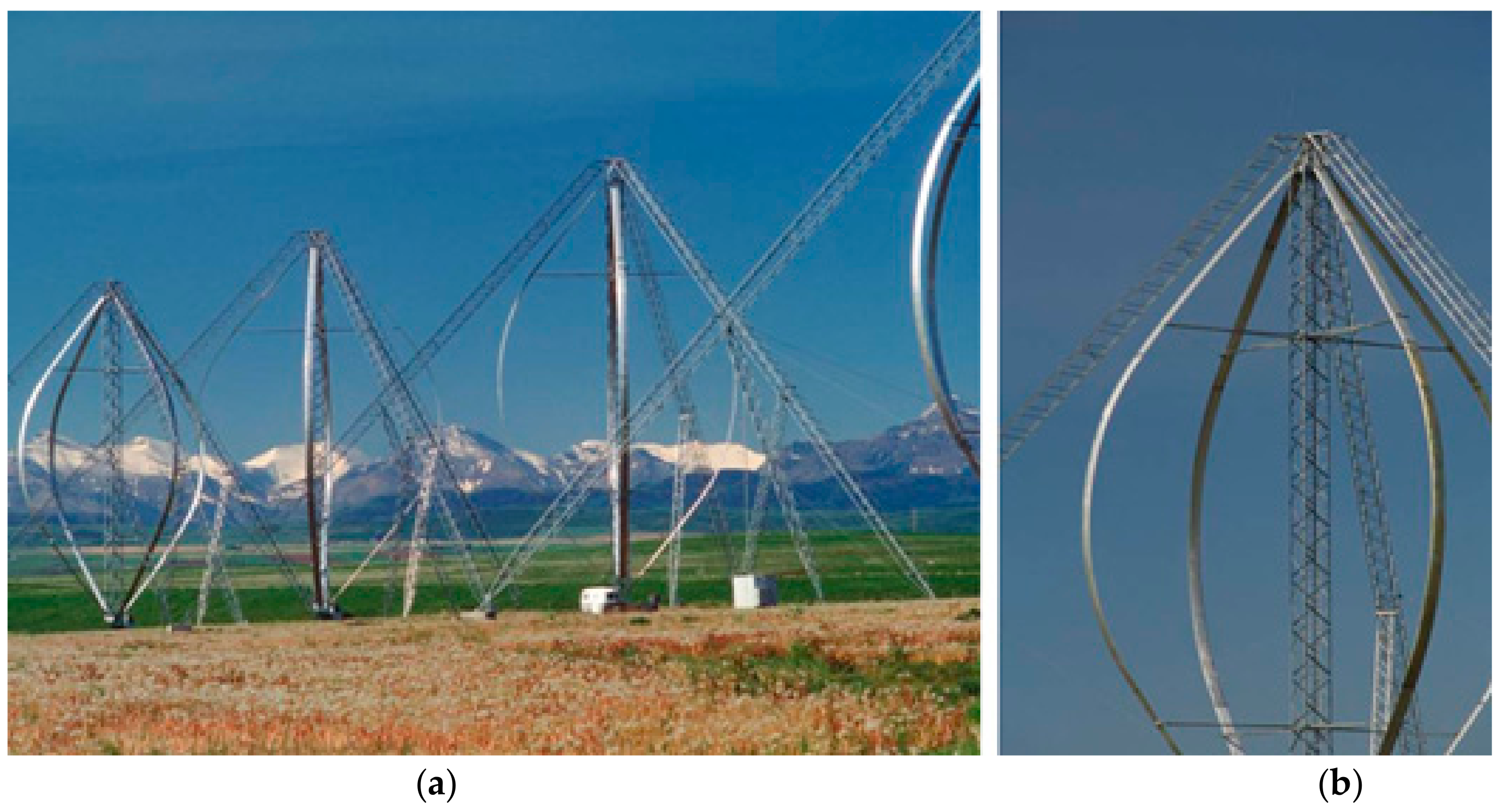
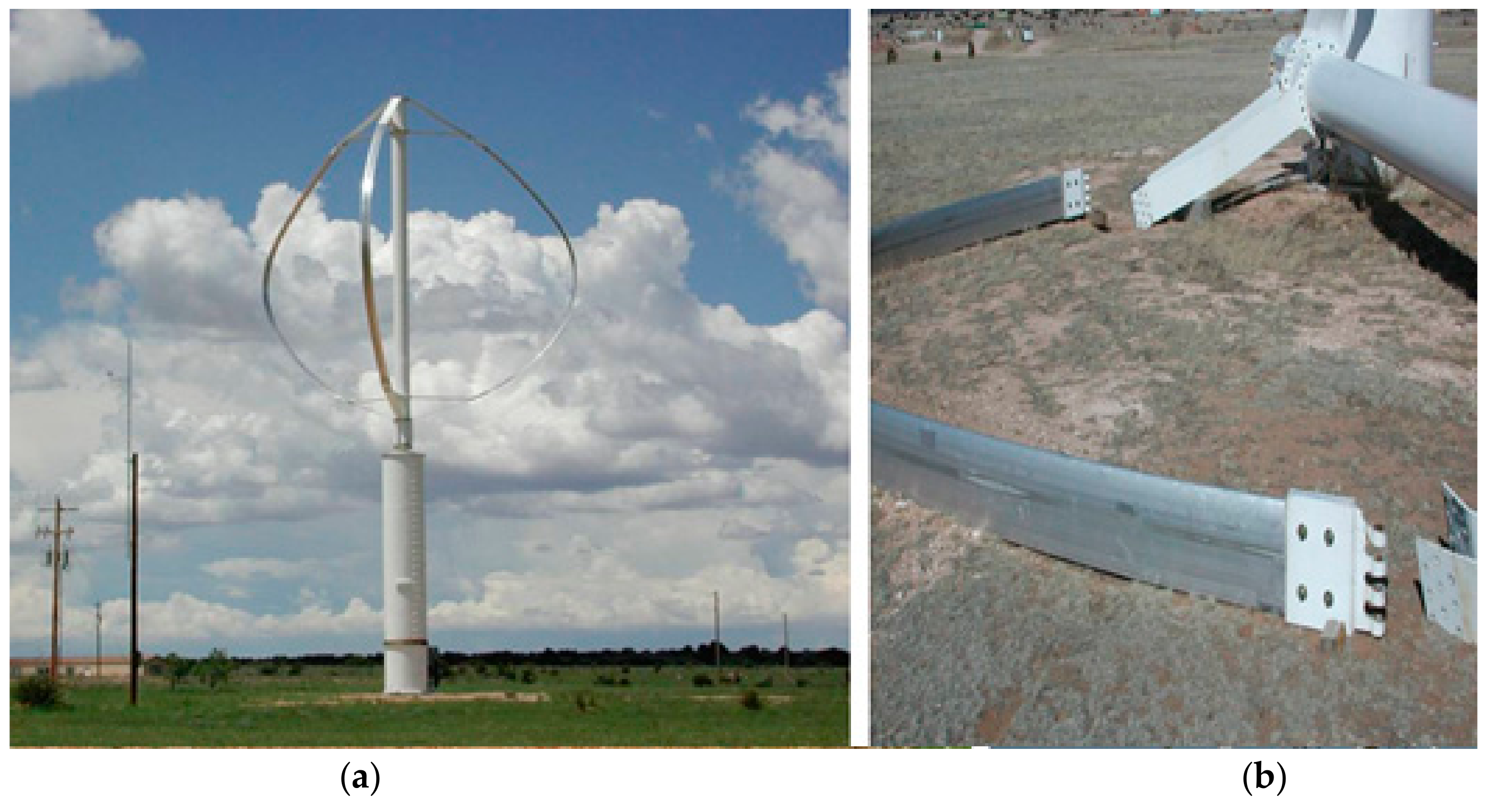
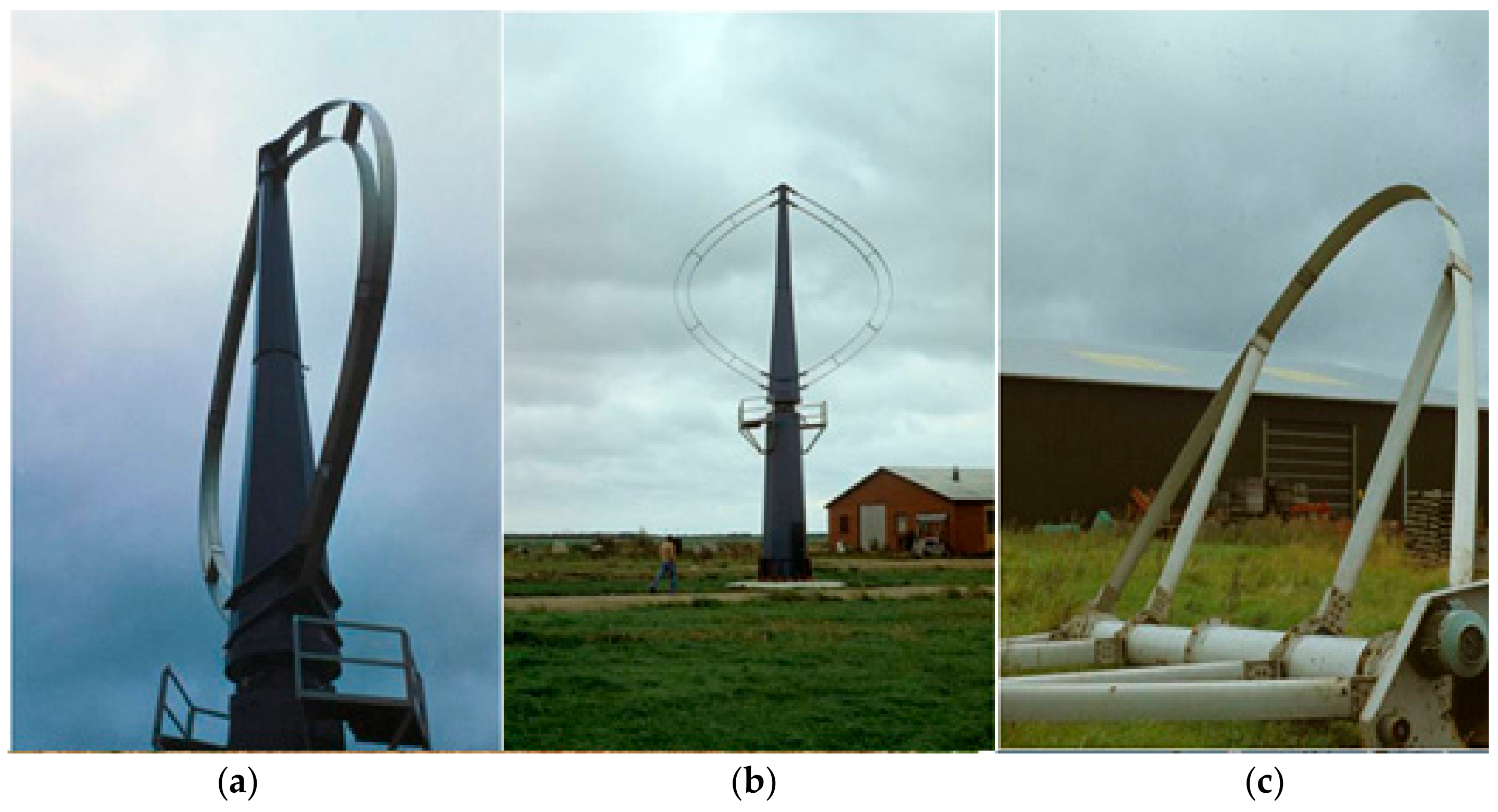
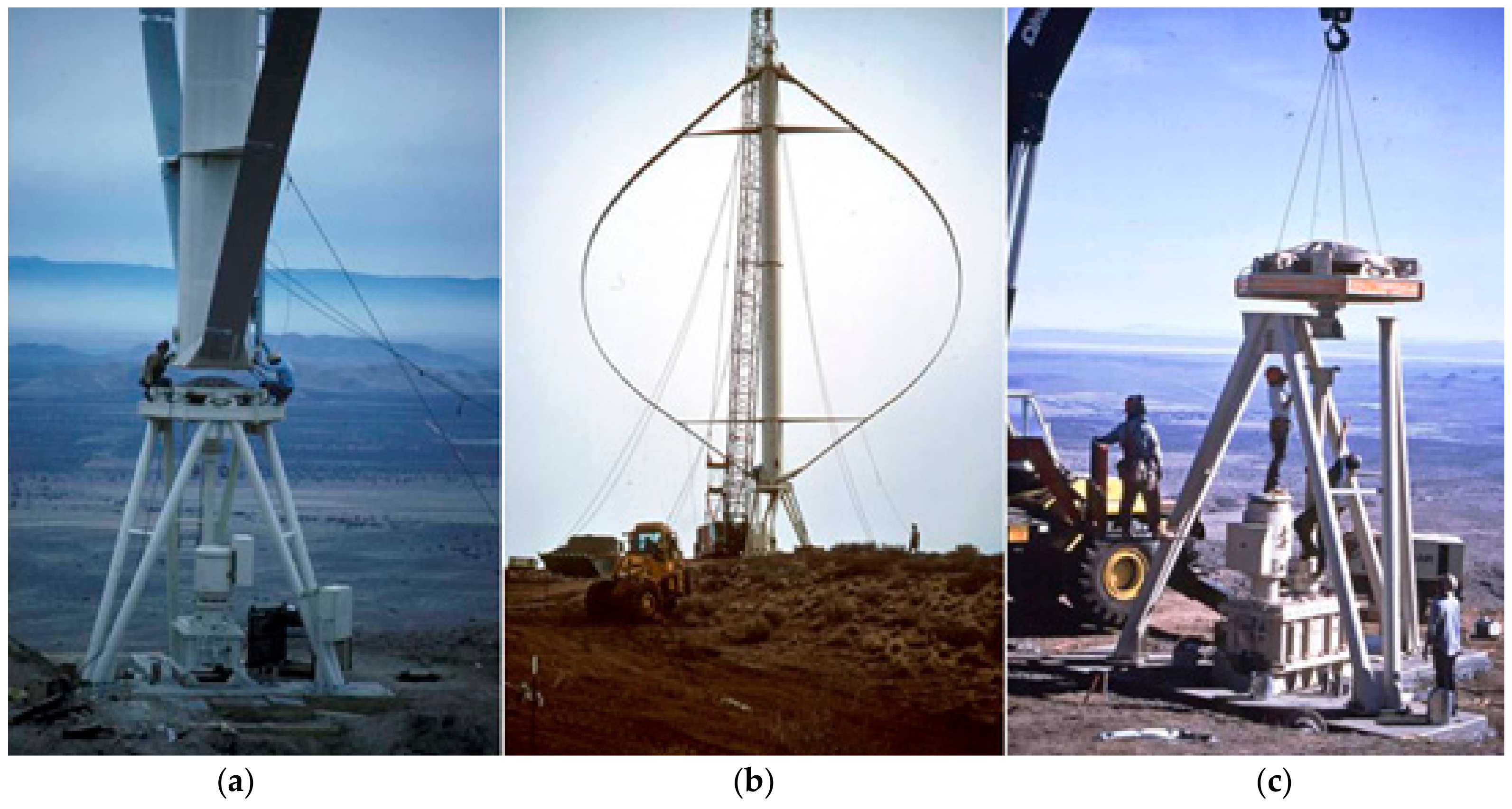



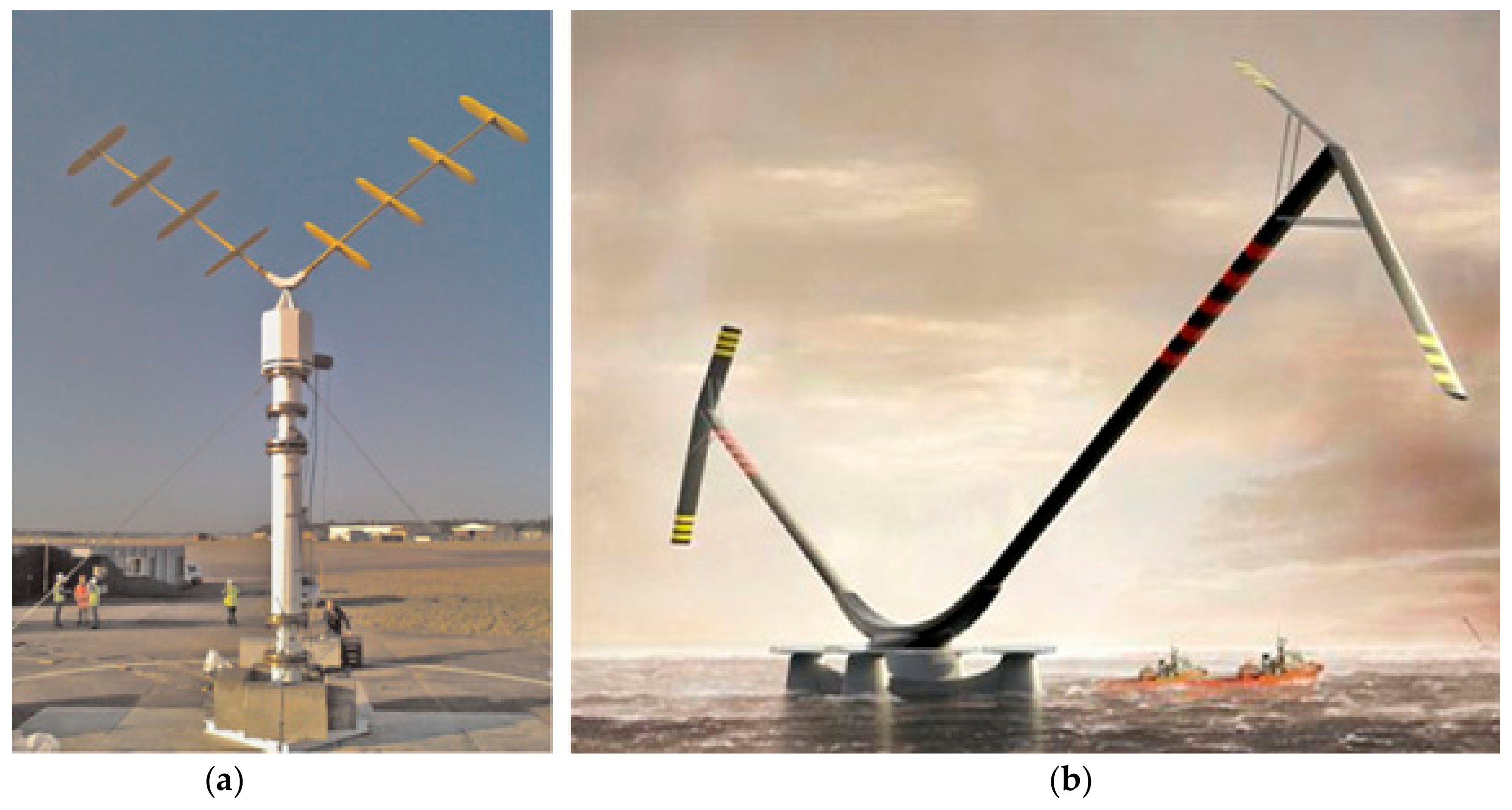
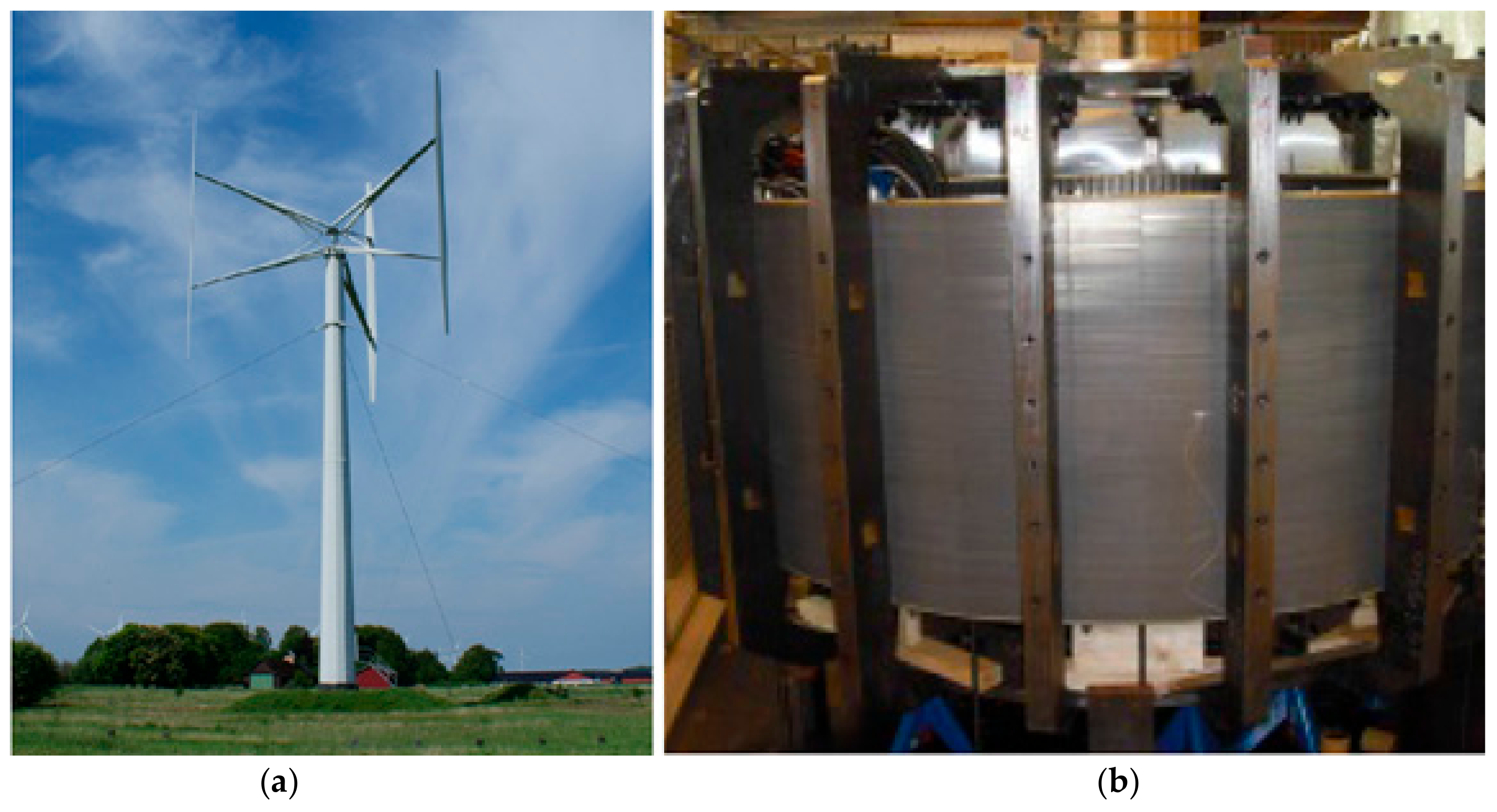

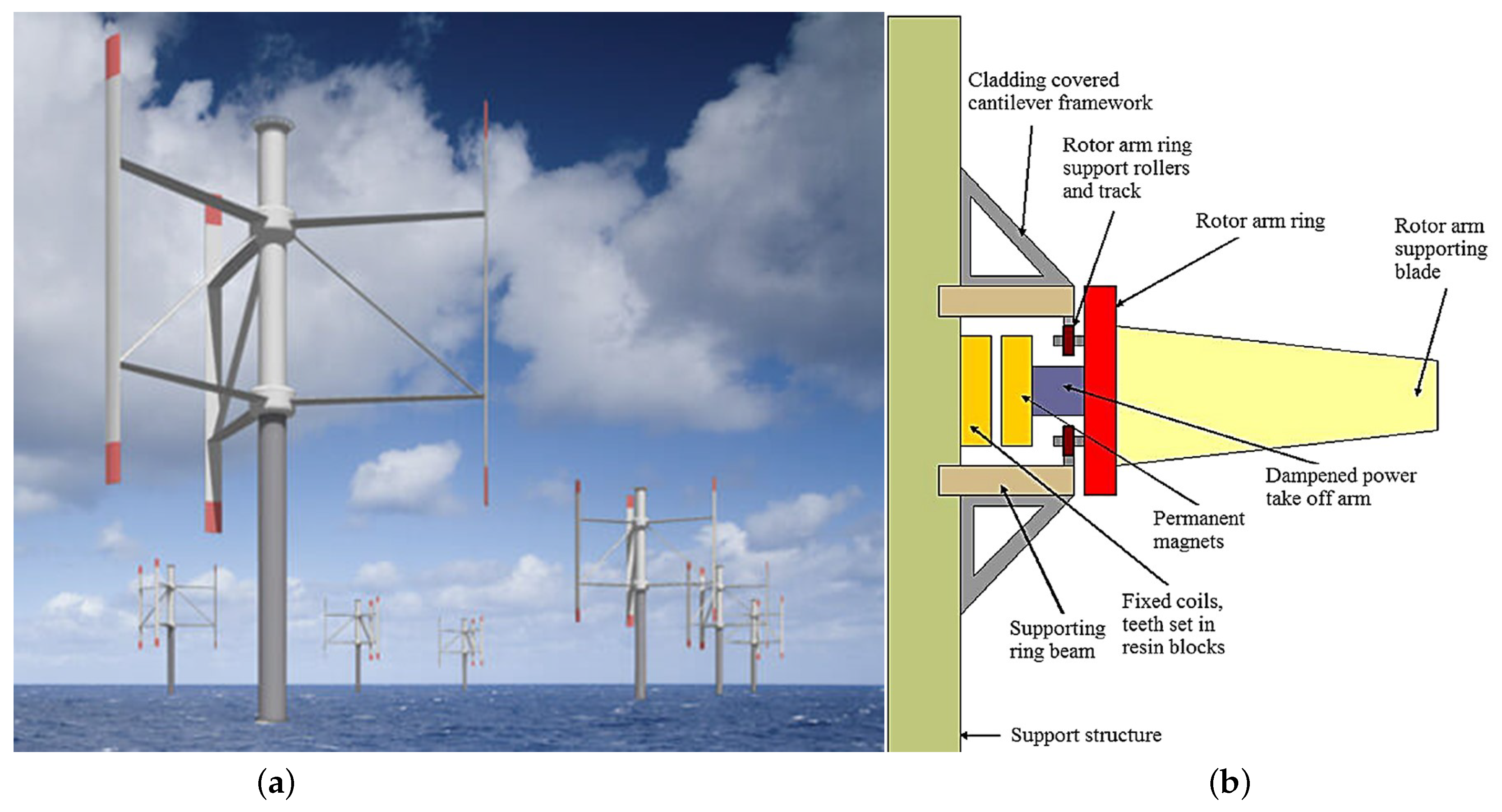
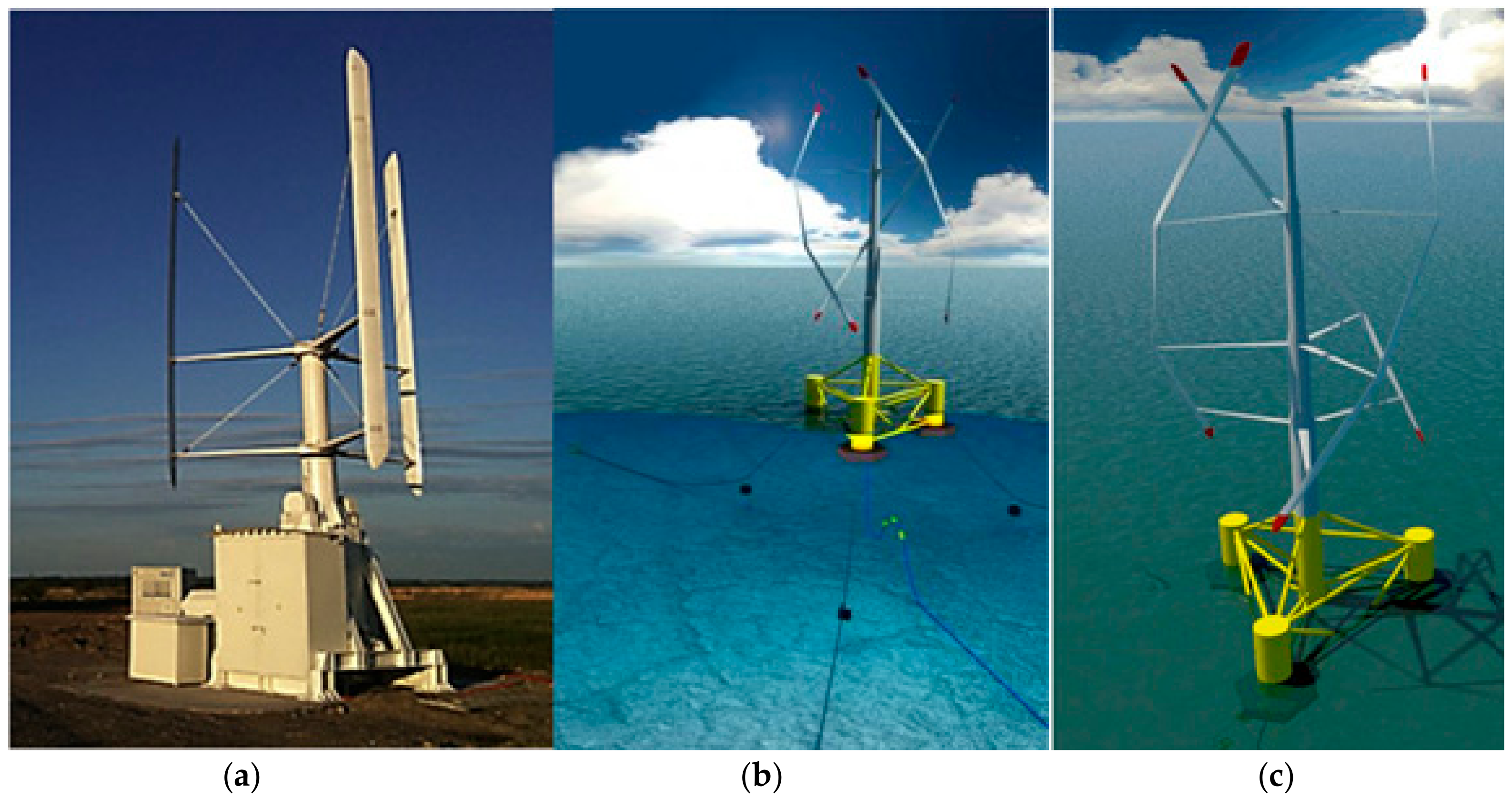

© 2019 by the authors. Licensee MDPI, Basel, Switzerland. This article is an open access article distributed under the terms and conditions of the Creative Commons Attribution (CC BY) license (http://creativecommons.org/licenses/by/4.0/).
Share and Cite
Mohan Kumar, P.; Sivalingam, K.; Lim, T.-C.; Ramakrishna, S.; Wei, H. Review on the Evolution of Darrieus Vertical Axis Wind Turbine: Large Wind Turbines. Clean Technol. 2019, 1, 205-223. https://doi.org/10.3390/cleantechnol1010014
Mohan Kumar P, Sivalingam K, Lim T-C, Ramakrishna S, Wei H. Review on the Evolution of Darrieus Vertical Axis Wind Turbine: Large Wind Turbines. Clean Technologies. 2019; 1(1):205-223. https://doi.org/10.3390/cleantechnol1010014
Chicago/Turabian StyleMohan Kumar, Palanisamy, Krishnamoorthi Sivalingam, Teik-Cheng Lim, Seeram Ramakrishna, and He Wei. 2019. "Review on the Evolution of Darrieus Vertical Axis Wind Turbine: Large Wind Turbines" Clean Technologies 1, no. 1: 205-223. https://doi.org/10.3390/cleantechnol1010014
APA StyleMohan Kumar, P., Sivalingam, K., Lim, T.-C., Ramakrishna, S., & Wei, H. (2019). Review on the Evolution of Darrieus Vertical Axis Wind Turbine: Large Wind Turbines. Clean Technologies, 1(1), 205-223. https://doi.org/10.3390/cleantechnol1010014






